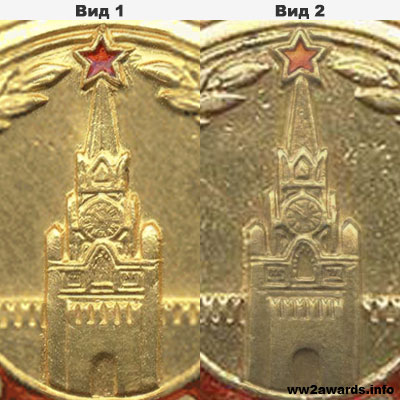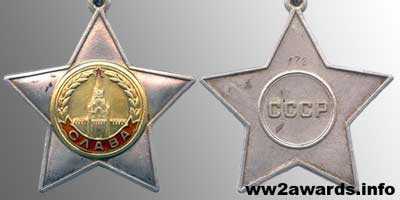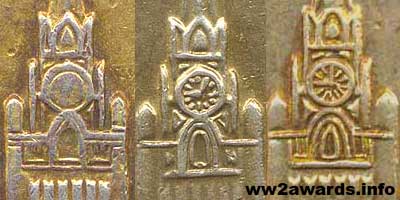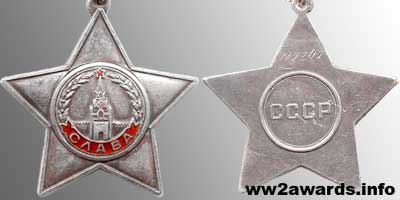Order of Glory
The Order of Glory - established to reward ordinary soldiers and sergeants of the Soviet Army, as well as junior lieutenants of the USSR Air Force, was established on November 8, 1943.

History Order of Glory
In November 1943, along with the Order of Victory, another award was established, the Order of Glory. In contrast to the general order of the Victory, this award was intended for privates and sergeants of the Red Army, as well as for the lieutenants of the USSR Air Force.
Work on the project order, with the working title of the Order of Bagration, began in August 1943. It was assumed that the order would have four classes and a ribbon of orange-black colors (color of flame and smoke). From 26 sketches provided to the chief of the Main Directorate of the Red Army Logistics, General Khrulev, he was selected four, which on October 2, 1943, were submitted to Stalin.
In the final version, Stalin chose the design Moskalev NI, and proposed to reduce the number of classes to three, by analogy with the orders of Suvorov and Kutuzov, while agreeing with the author`s proposal to use a tape similar to the St. George ribbon of pre-revolutionary Russia. In addition, adding that there is no victory without glory, Stalin proposed renaming the award to the Order of «Glory».
The final design of the award was approved on October 23, 1943. The Order was established by the Decree of the Presidium of the Supreme Soviet of November 8, 1943. Subsequently, the Statute of the Order was partially amended by Decrees of the Presidium of the Supreme Council of February 26 and December 16, 1947, and of August 8, 1957.
Order of Glory - a five-pointed star in the center of which is a circle with the image of the Spasskaya Tower of the Moscow Kremlin, in the lower part of the ribbon with the inscription «СЛАВА» (GLORY), along the edges of the circle is a laurel wreath, ribbon and star on the tower enameled with red enamel. Order with the help of a ring is attached to a pentagonal block, covered with a silk moire ribbon with three black and two orange stripes of equal width.
The Soviet Order of Glory is one of the unique orders in the history of the Soviet award system, first, it practically repeats the St. George cross on ideology, or as it was also called the «soldier George» of pre-revolutionary Russia. Seriously even considered the issue of legitimization of the St. George Cross and equating his knights to the Knights of the Order of Glory. Secondly, they were awarded exclusively sequentially from the third to the first classes. Thirdly, the award of all classes had the same ribbon. Fourthly, it was the only order awarded solely to soldiers and sergeants (in aviation to junior lieutenants).
In addition, the Order of Military Glory was one of the few Soviet orders to which only people were awarded. In history, only one award is known, which goes beyond this framework, after the successful storming of the fortifications of the enemy on the Vistula River, all soldiers and sergeants of the first battalion of the 215th Guards Regiment were awarded the Order of Glory, and after a while this award was received and the battalion, which from that moment became known as the battalion of Glory.
List of recipients Order of Glory
For more rapid awarding in combat, the right to award the Order of Glory to the 3rd class was given to the commanders of the formations, from the brigade and above, the Order of Glory of the 2nd class - to the army commander and the 1st class, solely to the Presidium of the USSR Armed Forces. After the end of the war, from February 26, 1947, the right to award all classes of the Order of Glory was possessed exclusively Presidium of the USSR Armed Forces.
The first decree on awarding is dated November 13, 1943, Malyshev V.S. became the first gentleman of the Order of Glory of the III class. For the fact that during the battle he was able, to approach and destroy the enemy machine gun that prevented the offensive of the troops.
The sapper, Sergeant Israelyan G.A., who received his award on November 17, 1943, became the first knight to receive the Order of Glory of the III degree. As a result, Malyshev is the first person to be presented to the award, but received it later, and Israelyan is physically the first to be awarded the Order of Glory.
The first awarding of the Order of Glory II class was held on December 10, 1943. Cavaliers were the sappers of the 10th Army of the Western Front, soldiers Baranov S.I. and Vlasov A.G.
The first awarding of the Order of Glory 1st class was held on July 22, 1944. The first full cavaliers were the assistant platoon commander, senior Sergeant Shevchenko K.K. and sapper, Corporal Pitenin M.T.
Since the manufactured orders were sent to different parts of the front in parties, and there they were distributed among the headquarters of the military units that had the right to award this order, the order numbering had a wide range, and the order with a low number, by its date, could be issued later than the high order number.
Order of Glory 1st class, number 1, received the commander of the infantry division, Guard Sergeant Nikolai Zaletov (63rd Guards Rifle Division of the Leningrad Front), decree of the Presidium of the USSR Supreme Soviet on October 5, 1944.
The badge of the Order of Glory I class number 2 was received by a soldier of the same 63rd Guards Infantry Division, Sergeant Ivanov VS (Decree of the Presidium of the Supreme Soviet of the USSR of March 24, 1945).
In connection with the confusion introduced by the war in the documents, there are cases of re-awarding the order of the same class (most often the third), one person. For example, Khristenko Vasily Timofeevich was awarded the Order of Glory III class on February 22, 1944, and then again on November 4, 1944. Later, Vasily Timofeevich became a full knight of the Order of Glory (2nd class — January 24, 1945, and 1st class — May 15, 1946). Besides him, three more cavaliers of the Order of Glory of three classes had four awards each with an order. These cavaliers: Alimurat Gaibov, scout of the 128th Mountain and Rifle Division (two Orders of Glory II class); Vasily Naldin, gunner of the 1071 fighter antitank artillery regiment; Alexei Petrukovich, Sergeant major of the 35th Guards Rifle Division.
Among almost three thousand full knights of the Order of Glory, four were awarded the title of Hero of the Soviet Union. These cavaliers: artilleryman guards senior Sergeant A. Aleshin; pilot-attack aircraft, junior aviation lieutenant Drachenko I.G.; Marine, Guard Sergeant Dubinda P.H; artilleryman, senior sergeant N. Kuznetsov. (He received the Order of the 1st class only in 1980).
In addition, the full knights of the Order of Glory are four women: a sniper, Sergeant Petrova N.P.; the machine-gunner of the 16th Lithuanian Division, Sergeant Stanilene D.J.; nurse, Sergeant Nozdracheva M.S.; air gunner-radio operator of the 99th separate Guards reconnaissance air regiment of the 15th Air Army, guard sergeant Zhurkina N.A.
Cavalier of two St. George crosses, a soldier Kuzin S.T., fighting during the war in the ranks of the Red Army, became a knight of two Orders of Glory.
Total awards were awarded to the Order of Glory 1st class - 2674, 2nd class - 46473, 3rd class - 997815.
Order of Glory in the award system of the USSR
Prices for Order of Glory
To date, prices for the Order of Glory start from:
Order of Glory first class
1943-91 Order of Glory first class ≈2674 pcs. - 7000 $
Order of Glory second class
1943 Type 1 «Reverse with rim» ≈1000 pcs. - 2500 $
1944-45 Type 2 «Thin» ≈20000 pcs. - 600 $
1945-91 Type 3 «Thick» ≈25500 pcs. - 500 $
Order of Glory third class
1943 Type 1 «Reverse with rim» ≈900 pcs. - 2000 $
1943 Type 2 «clock on 11:52» ≈100000 pcs. - 55 $
1944-91 Type 3 «1944-91» ≈700000 pcs. - 50 $
The price has been updated on: 15.10.2025 yr.
Varieties of the Order of Glory I class

Number 1-3776
Gold 950. Gold content in the order 28.6±1.5 g. Total weight-30.4±1.5 g.
Collectors share two subspecies of this order. In earlier versions, the numbers 1-3000 digits of the dial on the chimes of the Moscow Kremlin relief, Roman.
A later version of the Order, numbers 3136-3776 differs in that on the dial the Roman numerals are replaced by abstract labels. In addition, later versions have a number of minor differences, so the star on the top of the sign, stopped touching the outer rim, and below it disappeared a groove, between the tower and the enameled tape.
Varieties of the Order of Glory II class
Type 1 «Reverse with the rim» 1943 year

Number 4–1773
Orders of the second degree were made of silver, with the application of gilding on the central medallion.
The first variants of the Order have on the reverse, a border, 1 mm high along the contour of the star. The dial on the Spassky Tower of the Moscow Kremlin is made in Roman numerals; the clock indicates 11:52.
Type 2 «Thin» 1944-45 years

Number 747-18680
The second type of the Order of Glory 2 class differs from the first, the absence of a rim along the contour of the star on the reverse.
The rest of the sign of the order is the same as the first type; the clock also shows 11:52 and is executed with Roman numerals. The thickness of the order is 1-1.5 mm.
Type 3 «Thick» 1945-91

Number 15634-49365
The main difference between the third types of order is its thickness, which is now 1.75-2 mm. In addition, collectors distinguish several types of «Thick» Order, differing for hours on the Spassky Tower:
Smooth dial (no arrows and marks on the watch), numbers 15634-24687;
The clock shows 9:05, numbers 25445-32647;
The clock shows 9:00, numbers 24722-49395.
Varieties of the Order of Glory III class
Type 1 «Reverse with the rim» 1943 year

Number 6-955
Order of Glory 3 class completely made of silver, with enamel coating stars and ribbons.
A distinctive feature of the first type also as of the second degree of the order is a 1 mm wide rim on the reverse along the star contour. The clock on the Spassky Tower shows 11:52. The numbers on the dial are convex, Roman. Serial number is printed manually.
Type 2 «clock on 11:52» 1943 year

Number ≈ 1000-166000
The second type of the Order of Glory III class is distinguished by the absence of a 1 mm wide rim along the contour of the star on the reverse.
All other details correspond to the order of the first type, the dial is also made with Roman numerals, and the clock indicates 11:52.
Type 3 «1944-91» 1944-91 years

Number ≈ 130000-340000
The third type of the order was made since 1944 and differs from the previous one in that time it not equal 11:52. Collectors distinguish several variants of this type of order, depending on the time on the watch and the way the numbers are placed:
Smooth dial (there are no arrows and marks on the clock), the number is the graver, number range ≈ 130000-340000;
The clock shows 10:12, the number of the graver, number range ≈ 314000-405000;
The clock shows 9:00, the number with the graver, number range ≈ 348000-367300;
The clock shows 12:10, the number is the graver, number range ≈ 365000-391200;
The clock shows 15:02, the number with the graver, number range ≈ 349784-421660;
The clock shows 9:05, the number with the graver, number range ≈ 367705-626190;
The clock shows 9:00, the number is stamped with a drill, number range ≈ 352828-813370;
Statute of the Order of Glory
Order of Glory is awarded to privates and sergeants of the Red Army, and to aviation junior lieutenants, who displayed glorious feats of bravery, courage and fearlessness in combat for the Soviet Motherland.
The Order consists of three classes: I, II and III class. The highest degree of the Order of Glory is the I class. Rewarding is performed sequentially: first the third, then second and, finally, first class.
The Order of Glory is awarded for the fact that:
- For leading the initial strike into an enemy position, and personal courage that contributed to the success of the common cause;
- For pressing on an attack in a burning tank;
- For saving the banner from capture by the enemy in a moment of grave danger;
- For displayed marksmanship in the killing of from 10 to 50 enemy soldiers and officers using personal weapons;
- For the destruction of at least 2 enemy tanks while manning an anti-tank gun;
- For the destruction of between 1 and 3 enemy tanks with hand grenades on the field of battle or behind enemy lines;
- For the destruction of at least 3 enemy aircraft with artillery or machine gun fire;
- For despising danger by being the first to burst into an enemy bunker (bunker, trench or dugout), for decisive actions that destroyed its occupants;
- For leading our troops in the enemy`s rear through weaknesses in his defenses found because of personal reconnaissance;
- For personally capturing an enemy officer;
- For night, watch action resulting in an enemy death or capture;
- For displayed ingenuity and boldness in making one is way to the enemy position and destroying his machine gun or mortar;
- For participation in a night raid, destroying enemy military stores and property;
- For risking one`s life while saving one`s commander from imminent danger in battle;
- For showing neglect for personal danger in the capture of an enemy banner in battle;
- For being seriously wounded but returning to the battle after minimal medical care;
- For downing an enemy aircraft with personal weapons;
- For destroying enemy weapons and positions with accurate artillery or mortar fire ensuring the success of the mission;
- For making a passage through the enemy`s barbed-wire entanglements while under fire;
- For selflessness in the rescue of the wounded during battle;
- For carrying on in a mission in a tank with a defective main gun;
- For quickly smashing a tank into an enemy convoy and carrying on with the mission after its destruction;
- For crushing with one`s, tank one or more enemy guns or destroying at least two machine gun nests;
- For gathering valuable intelligence from the enemy while on reconnaissance;
- Fighter pilot – For downing between 2 and 4 enemy fighters or 3 to 6 enemy bombers.
- Fighter pilot – For a successful air attack that resulted in between 2 and 5 destroyed enemy tanks, or from 3 to 6 locomotives, or the destruction of an entire train, or the destruction of at least 2 enemy aircraft on their airfield.
- Fighter pilot – For bold actions in an air battle resulting in the destruction of one or two enemy aircraft.
- Day bomber crews – For the destruction of a railway station or marshalling yard, a bridge, ammunition dump, fuel stores, enemy headquarters or troop compound, power station, sunk enemy vessel, naval transport, launch, at least 2 enemy aircraft on their airfield.
- Day bomber crews – Bold action in aerial combat resulting 1 or 2 enemy planes shot down.
- Night light bomber crews – For the destruction of an ammunition dump, fuel stores, enemy headquarters, an entire train, a bridge.
- Long-range night bomber crews – For the destruction of a railway station or marshalling yard, ammunition dump, fuel stores, port facilities, naval transports, an entire train, an important plant or factory.
- Reconnaissance – For a highly successful reconnaissance mission, which resulted in valuable intelligence about the enemy.
Awarding the Order of Glory made by the Decree of the Presidium of the Supreme Soviet of the USSR.
Awarded with the Orders of Glory of all three class are awarded the right to confer a military rank:
- privates, corporals and sergeant - sergeant major;
- sergeant major - junior lieutenant;
- junior lieutenants in aviation - lieutenant.
The Order of Glory was worn on the left side of the chest. In the presence of other USSR orders and medals, it was worn immediately after the Order of the Badge of Honor.
Updated: 2025-10-15 03:49:59